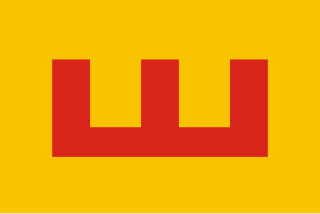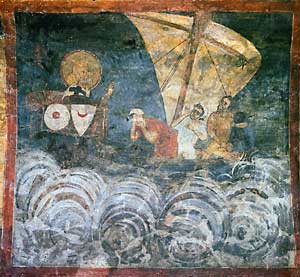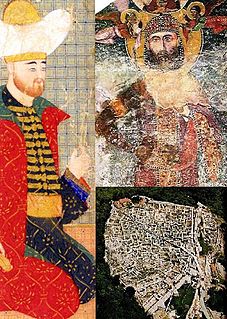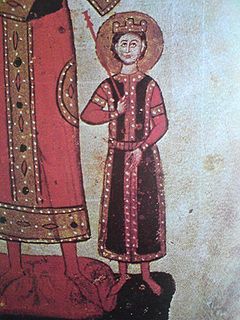| Michael Asen IV | |
|---|---|
Coin depicting Ivan Alexander and his son Michael Asen IV | |
| Born | 1322 |
| Died | 1355 |
| Spouse | Maria-Irene Palaiologina |
| House | Shishman |
| Father | Ivan Alexander |
| Mother | Theodora |
Michail Asen (Bulgarian : Михаил Асен) (c. 1322–1355) was the eldest son of Ivan Alexander of Bulgaria from his marriage with Theodora of Wallachia.

Bulgarian, is an Indo-European language and a member of the Southern branch of the Slavic language family.

Ivan Alexander, also sometimes Anglicized as John Alexander, ruled as Emperor (Tsar) of Bulgaria from 1331 to 1371, during the Second Bulgarian Empire. The date of his birth is unknown. He died on 17 February 1371. The long reign of Ivan Alexander is considered a transitional period in Bulgarian medieval history. Ivan Alexander began his rule by dealing with internal problems and external threats from Bulgaria's neighbours, the Byzantine Empire and Serbia, as well as leading his empire into a period of economic recovery and cultural and religious renaissance.
Theodora of Wallachia was the daughter of Basarab I of Wallachia and Lady Margareta. She married Ivan Alexander of Bulgaria as his first wife. This marriage produced four children — Michael Asen, Ivan Sratsimir, Ivan Asen and Vasilisa. In 1345 Tsar Ivan Alexander divorced Tsaritsa Theodora and sent her into a monastery as a nun under the name Teofana.
After his father acceded to the throne in 1331, the young prince was proclaimed co-Emperor. He was to succeed his father under the name Michael IV Asen. [1] The heir to the throne was the pride of the royal family and was said to possess "all virtues". He married Maria, renamed Irina, the daughter of Andronikos III Palaiologos.
Irene Palaiologina was a Byzantine princess and Bulgarian empress consort. She was also known as Maria Palaiologina.

Andronikos III Palaiologos, commonly Latinized as Andronicus III Palaeologus, was Byzantine emperor from 1328 to 1341. Born Andronikos Doukas Angelos Komnenos Palaiologos, he was the son of Michael IX Palaiologos and Rita of Armenia. He was proclaimed co-emperor in his youth, before 1313, and in April 1321 he rebelled in opposition to his grandfather, Andronikos II Palaiologos. He was formally crowned co-emperor in February 1325, before ousting his grandfather outright and becoming sole emperor on 24 May 1328.
In 1354–1355 the Ottoman Turks invaded Bulgaria and headed towards Plovdiv and Sofia. It is mentioned in an anonymous Bulgarian chronicle that Michail Asen gathered the Bulgarians and engaged the Turks near Sofia. The Bulgarians were defeated and suffered heavy casualties including Michail himself. But the battle was not in vain: the Ottomans failed to capture the cities and did not attack the country up to 1370. [2] In the Bulgarian folklore is mentioned that the son of the Emperor perished with the death of the brave.
The Ottoman Turks were the Turkish-speaking population of the Ottoman Empire who formed the base of the state's military and ruling classes. Reliable information about the early history of Ottoman Turks is scarce, but they take their Turkish name, Osmanlı, from the house of Osman I, the founder of the dynasty that ruled the Ottoman Empire for its entire 624 years. After the expansion from its home in Bithynia, the Ottoman principality began incorporating other Turkish-speaking Muslims and non-Turkish Christians, becoming the Ottoman Turks and ultimately the Turks of the present. The Ottoman Turks blocked all land routes to Europe by conquering the city of Constantinople, the capital city of the Byzantine–East Roman Empire, and Europeans had to find other ways to trade with Eastern countries.

Plovdiv is the second-largest city in Bulgaria, with a city population of 346 893 as of 2018 and 675,000 in the greater metropolitan area. It is an important economic, transport, cultural, and educational center. There is evidence of habitation in Plovdiv dating back to the 6th millennium BCE, when the first Neolithic settlements were established. It has been considered to be one of the oldest cities in the world however archaeological excavations in 2016 and 2017 have shown that this may not be the case.

Sofia is the capital and largest city of Bulgaria. The city is at the foot of Vitosha Mountain in the western part of the country. Being in the centre of the Balkan peninsula, it is midway between the Black Sea and the Adriatic Sea, and closest to the Aegean Sea.











